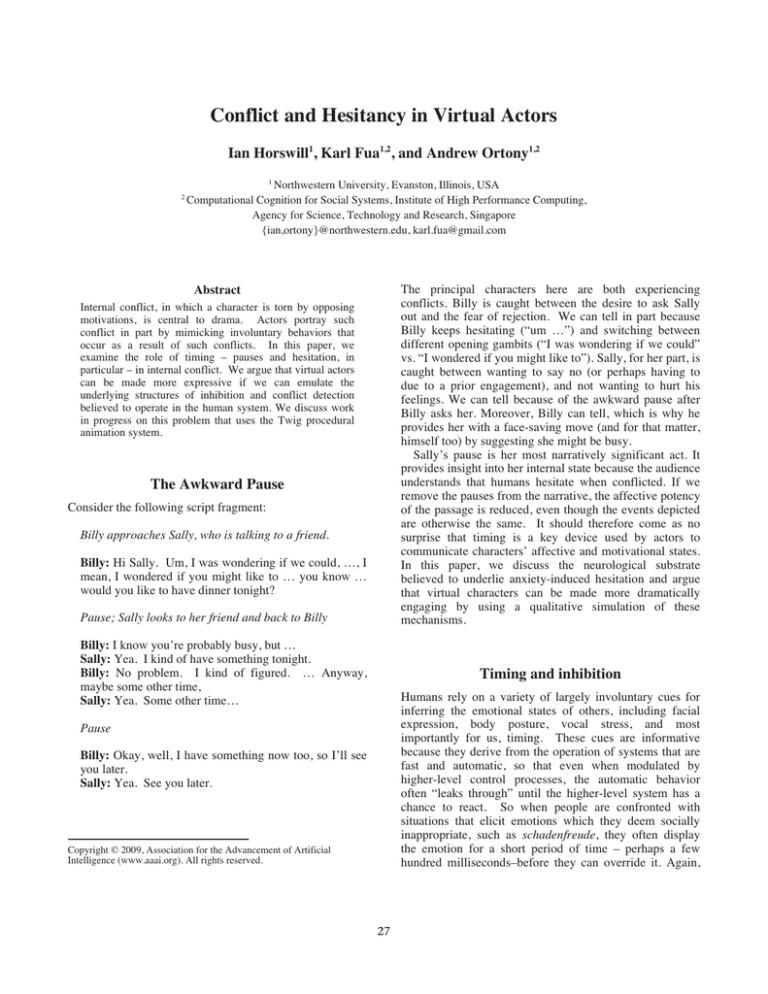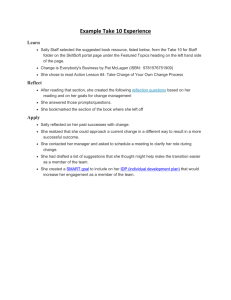
Conflict and Hesitancy in Virtual Actors
Ian Horswill1, Karl Fua1,2, and Andrew Ortony1,2
1
2
Northwestern University, Evanston, Illinois, USA
Computational Cognition for Social Systems, Institute of High Performance Computing,
Agency for Science, Technology and Research, Singapore
{ian,ortony}@northwestern.edu, karl.fua@gmail.com
The principal characters here are both experiencing
conflicts. Billy is caught between the desire to ask Sally
out and the fear of rejection. We can tell in part because
Billy keeps hesitating (“um …”) and switching between
different opening gambits (“I was wondering if we could”
vs. “I wondered if you might like to”). Sally, for her part, is
caught between wanting to say no (or perhaps having to
due to a prior engagement), and not wanting to hurt his
feelings. We can tell because of the awkward pause after
Billy asks her. Moreover, Billy can tell, which is why he
provides her with a face-saving move (and for that matter,
himself too) by suggesting she might be busy.
Sally’s pause is her most narratively significant act. It
provides insight into her internal state because the audience
understands that humans hesitate when conflicted. If we
remove the pauses from the narrative, the affective potency
of the passage is reduced, even though the events depicted
are otherwise the same. It should therefore come as no
surprise that timing is a key device used by actors to
communicate characters’ affective and motivational states.
In this paper, we discuss the neurological substrate
believed to underlie anxiety-induced hesitation and argue
that virtual characters can be made more dramatically
engaging by using a qualitative simulation of these
mechanisms.
Abstract
Internal conflict, in which a character is torn by opposing
motivations, is central to drama. Actors portray such
conflict in part by mimicking involuntary behaviors that
occur as a result of such conflicts. In this paper, we
examine the role of timing – pauses and hesitation, in
particular – in internal conflict. We argue that virtual actors
can be made more expressive if we can emulate the
underlying structures of inhibition and conflict detection
believed to operate in the human system. We discuss work
in progress on this problem that uses the Twig procedural
animation system.
The Awkward Pause
Consider the following script fragment:
Billy approaches Sally, who is talking to a friend.
Billy: Hi Sally. Um, I was wondering if we could, …, I
mean, I wondered if you might like to … you know …
would you like to have dinner tonight?
Pause; Sally looks to her friend and back to Billy
Billy: I know you’re probably busy, but …
Sally: Yea. I kind of have something tonight.
Billy: No problem. I kind of figured. … Anyway,
maybe some other time,
Sally: Yea. Some other time…
Timing and inhibition
Humans rely on a variety of largely involuntary cues for
inferring the emotional states of others, including facial
expression, body posture, vocal stress, and most
importantly for us, timing. These cues are informative
because they derive from the operation of systems that are
fast and automatic, so that even when modulated by
higher-level control processes, the automatic behavior
often “leaks through” until the higher-level system has a
chance to react. So when people are confronted with
situations that elicit emotions which they deem socially
inappropriate, such as schadenfreude, they often display
the emotion for a short period of time – perhaps a few
hundred milliseconds–before they can override it. Again,
Pause
Billy: Okay, well, I have something now too, so I’ll see
you later.
Sally: Yea. See you later.
Copyright © 2009, Association for the Advancement of Artificial
Intelligence (www.aaai.org). All rights reserved.
27
1994, cited in Gray and McNaughton 2000). The fastest
(and dumbest) of these is the startle response, which
initiates a mere 10ms after stimulus onset, and involves a
range of reactions from eye blink, to head reorientation,
increased muscle tone, and autonomic adjustment. The
flight/flight/freeze system involves its own hierarchy of
systems implementing progressively smarter responses at
the cost of longer latencies. The lowest level (in the
periaqueductal grey matter) implements undirected escape
(flight without collision avoidance) and explosive attack.
Another, slower to respond, system (in medial
hypothalamus) is able to select a safe direction in which to
flee by overriding the escape system. Above these
systems, another system (in the amygdala) mediates active
avoidance (not approaching the threat in the first place)
and the septo-hippocampal system, as discussed above,
mediates defensive approach (Blanchard and Blanchard
1990), wherein the animal needs to enter a potentially
threatening situation.
Finally, higher-level cortical
systems, particularly the cingulate and prefrontal cortices
perform higher-level processing.
actors rely on the mimicry of these patterns to
communicate their characters’ emotions.
This general computational organization – a fast, simple
system running in parallel with a slower, smarter system
that can inhibit it – is common in the brain. Moreover,
both systems can themselves have parallel subsystems that
compete through mutual inhibition. The central claim of
this paper is that much of the behavioral timing that is
central to dramatic performance is a side-effect of such
processes, and so their simulation is a productive way of
producing believable timing in virtual characters.
Conflict and anxiety
Anxiety is a particularly important inhibition mechanism
(Gray 1982).
In Gray and McNaughton’s (2000)
neuropsychological model of anxiety, the hippocampus,
which receives topographic projections from much of the
midbrain and cortex, acts as a “comparator” that detects
two primary conditions: expectation violations (including
novel stimuli), and conflicts between other behavioral
systems, particularly conflicts between approach and
avoidance response tendencies. It responds by inhibiting
both approach and avoidance, while simultaneously
stimulating behaviors related to information gathering,
such as environmental and memory scanning. The result is
an overall shift toward risk aversion, but also a general
inhibition of action, with the winning behavior often being
initially disrupted by involuntary pauses as the system
attempts to resolve the conflict.
In our example, Billy’s simultaneous attraction to Sally
and fear of rejection – an approach/avoidance conflict–
results in involuntary hesitation in his speech. Sally, caught
between wanting to reject and not wanting to hurt Billy’s
feelings, does neither, looking instead to her friend to
gauge her reaction (social referencing). She does not
respond at all until Billy effectively un-asks her, resolving
her conflict for her.
Discussion
Timing is an important channel for the communication of
affect and motivation, and we believe that by simulating
the underlying processes of inhibition and conflict
resolution we can produce expressive behavior in virtual
characters. We are currently developing a simulation of
the mammalian defense hierarchy inside Twig (figure 1,
Horswill 2009), an open-source procedural animation
system designed to interface well with AI systems.
One important issue is the level of detail at which to
simulate. Simulation of individual neurons is impractical,
both for computational reasons and because the systems
have not been mapped to that level. However, we believe
that a relatively coarse simulation at the level of whole
behavioral systems (startle, escape, etc.) should be
sufficient to produce believable pauses and hesitations of
the kinds discussed above, as well as behavioral cascades
in which a startled character might successively flinch,
jump, collide with an obstacle, swear, and finally relax, as
successive systems come on line with progressively more
refined responses.
References
Blanchard, R. J., and Blanchard, D. C. 1990. An
ethoexperimental analysis of defense, fear and anxiety. In
McNaughton, N., and Andrews, G., eds., Anxiety. Otago
University Press. 124–133.
Figure 1: Screenshot from Twig
The Mammalian Defense Hierarchy
Graef, F. G. 1994. Neuroanatomy and neurotransmitter
regulation of defensive behaviors and related emotions in
mammals. Brazilian Journal of Medical and Biological
Research, 27: 811-829.
The anxiety system forms one component of a larger
hierarchy of systems thought to underlie defense behaviors
throughout the mammalian line (LeDoux 1994, Graeff
28
Gray, J. 1982. The neuropsychology of anxiety: an enquiry
into the functions of the septo-hippocampal system. Oxford
University Press.
Gray, J., and McNaughton, N. 2000. The Neuropsychology
of Anxiety. Oxford: Oxford University Press.
Horswill, I. 2009. “Lightweight Procedural Animation
With Believable Physical Interactions”.
IEEE
Transactions on Computational Intelligence and AI in
Games. 1:1: 39-49.
LeDoux, J. E. 1994. Emotion, memory and the brain.
Scientific American, 270: 50-59.
29








